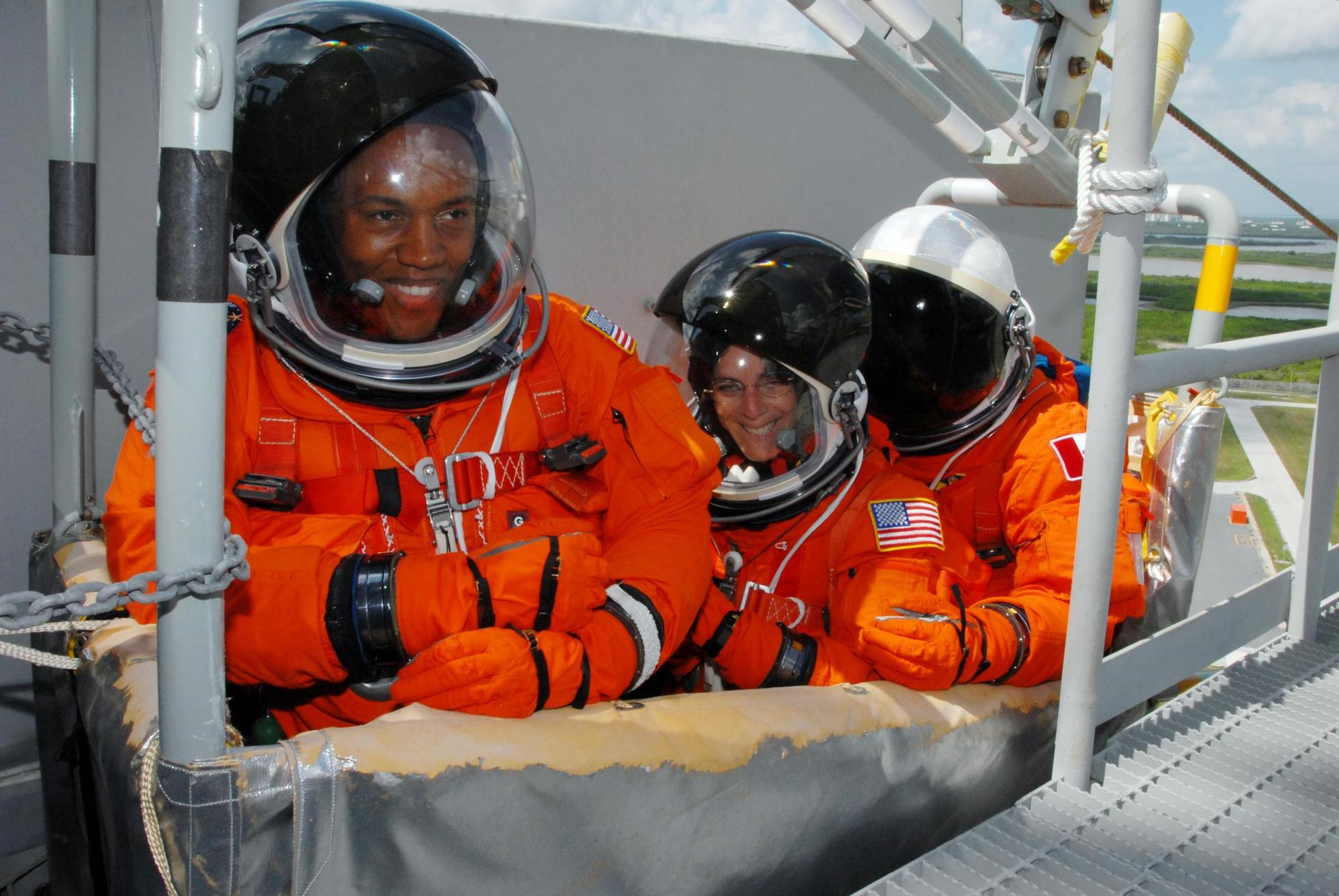'Space Rescue Service' needed for coming space tourism era, report argues
'The more people who fly in space, the higher the likelihood of something going wrong.'

Rescuers on Earth can reach a lot of rugged environments: stranded boaters in the ocean, folks injured while skiing in the mountains, and victims of plane crashes in rural areas.
But there's currently no emergency-rescue system for space — and there might be a way to change that. The nonprofit Rand Corp. suggests that a Space Rescue Service, if funded and given a strong enough mandate, could be deployed to help astronauts or tourists stuck in low Earth orbit — or even at the moon.
The idea was suggested in a November 2023 report, "Select Space Concepts for the New Space Era." To be sure, there are lots of questions that need to be answered before a Space Rescue Service can get up and running: how this fits in with existing United Nations treaties concerning space exploration, who would be responsible, who would fund it and what technologies might be needed, for example.
But should these challenges be met, author Jan Osburg told Space.com, the service would fill in a much-needed "gap" in space exploration. (He borrowed the word "gap" from a 2021 report about the space rescue issue by the Aerospace Corp., which influenced Rand's work.)
"It seems self-evident," Osburg said. "The more people who fly in space, the higher the likelihood of something going wrong."
Related: Medical emergencies will happen in deep space. Here's how Canada is getting ready
As of August 2023, fewer than 700 people have reached space, although the definition of space varies depending on who you talk to. The majority of those individuals have been professional astronauts. A select few were tourists who paid for their seats, however, or commercial astronauts with specific mission training, such as what we have seen on Axiom Space missions to the International Space Station or Inspiration-4, both of which used SpaceX Crew Dragon vehicles to reach orbit.
Breaking space news, the latest updates on rocket launches, skywatching events and more!
Of that small group of space-flying people, 21 died during their missions, according to Nigel Packham, NASA's associate director of safety and mission assurance, in a recent interview with Space.com sister publication LiveScience. (The number may vary depending on how space is defined, though.) Dozens of other people in space faced critical safety issues from which they recovered, such as Apollo 13's explosion on the way to the moon, or Gemini 8 spinning out of control above Earth.
Sometimes emergencies occur within a few seconds or minutes, Osburg acknowledged, but he said there was at least one case where a theoretical Space Rescue Service might have been useful for an extended issue. Engineers had suspicions about the integrity of heat shield tiles on NASA's space shuttle Columbia for days before its fatal return to Earth on Feb. 1 2003, given that video footage showed foam from a part of the external tank attachment appearing to slam into tiles near the orbiter's wing during its liftoff two weeks earlier. But for numerous reasons outlined in the long Columbia Accident Investigation Report, the astronauts still reentered Earth's atmosphere, and all seven of them lost their lives.
NASA implemented dozens of lessons learned from Columbia, of course, including having backup shuttles available at the launch pad for the remainder of the program in case of issues. Osburg added that the recent pace of SpaceX Falcon 9 rocket launches — which send people or satellites into space — suggests a new era in which multiple types of rocket could be on standby to help people in trouble, if there is time to rescue them.
Related: 20 years after Columbia shuttle tragedy, NASA pledges 'acute awareness' of astronaut safety
Osburg also pointed to the International Space Station as a location where numerous backups exist in case of trouble on board. "NASA has really solid plans," he said, given that both Russia's Soyuz and SpaceX's Dragon spacecraft regularly serve the orbiting complex now, and that Boeing's Starliner could be doing the same in the near future.
And the backup idea has already been put into practice, at least through the planning stage: When a Soyuz spacecraft docked at the ISS suffered a coolant leak late last year, calling into question its ability to carry its three crew members back to Earth safely, NASA rapidly created a backup scenario. The agency suggested allowing a fifth crew member to squeeze into a Dragon also docked at the ISS, using a modified seat attached to the floor. (Luckily, that idea never needed to be implemented, as a new Soyuz was launched to the ISS within weeks.)
Further in the future, Osburg pointed to SpaceX's nascent Starship deep-space transportation system as one key vehicle the community is waiting for. (SpaceX founder and CEO Elon Musk hopes that Starship will be able to launch several times a week, or even several times a day.) For low Earth orbit, companies like Virgin Galactic and Sierra Space are working on their own next-generation vehicles that can presumably fly astronauts several times a week, once they are ready.
Related: Meet 'Tenacity:' Sierra Space unveils 1st Dream Chaser space plane (photos)
While Osburg says any Space Rescue Service might be a decade or more away, the key is to start planning now — and Rand, he emphasized, is not attempting to take responsibility or to say that it would have all the answers about how to implement such an idea.
But there are ideas the community might be able to borrow from. For example, the International Submarine Escape and Rescue Liaison Office aims to rescue submariners no matter where they are stranded or what their nationality is. In space circles, another helpful example may be NASA's Planetary Defense Coordination Office (PDCO). That office was implemented shortly after a small asteroid unexpectedly exploded over Chelyabinsk, Russia on Feb. 15, 2013, to better coordinate a rapid response to such impacts.
The PDCO aims to link up several government organizations, as well as international partners, to deal with scenarios in which asteroids are imminently threatening Earth. The partners conduct regular tabletop exercises for now, to simulate what could be done if there ever were an impending impact. Happily, such scenarios remain hypothetical at the moment, for astronomers have not found any dangerous asteroids on a possible collision course with Earth yet despite decades of searching.
Osburg, who studies planetary defense issues as well, said a good defense strategy in that case also involves long-range planning: examples include space-based infrared sensors to seek out incoming asteroids, or a network of rapid response launch vehicles that can leave Earth on short notice.
"But there are challenges to balance between open global collaboration or unlimited global collaboration," he acknowledged, given security and trade issues. On the other hand, he added, "we're all in the same boat, and we've got to save the planet in the hopefully, extremely low-likelihood case that something big is headed our way."
The first few steps toward a Space Rescue Service could, Osburg said, start at regular space conferences at which researchers and engineers meet. "It starts with identifying organizations that are involved, both on the government side but also on the industry side," he said. Conversations must then happen about cost, and ways to make rescues easier; one is to continue the standardization of items such as docking ports to let spacecraft service each other in space when necessary, for example.
Some of the legal infrastructure might also be expandable, although Osburg emphasized that is not his area of expertise. Already, the United Nations has a framework for international collaboration under the 1967 Outer Space Treaty, which underlies most international space law, along with a "Rescue Agreement" for signatories to return stranded astronauts to their nation of origin here on Earth.
NASA also has its own international agreements for allies. The Artemis Accords cover both peaceful norms in space exploration and, for a select few signatories, agreements for cooperation on moon missions. The ISS agreement covers matters such as legal responsibilities on the space station, involving the signatories of that agreement; private operators such as Axiom Space follow strict rules to allow commercial astronauts on board.
Osburg added that, no matter how future agreements are implemented, all actors in space must have informed consent about the risks — including space tourists. "You can't plan for every single contingency, or provide resources."

Elizabeth Howell (she/her), Ph.D., was a staff writer in the spaceflight channel between 2022 and 2024 specializing in Canadian space news. She was contributing writer for Space.com for 10 years from 2012 to 2024. Elizabeth's reporting includes multiple exclusives with the White House, leading world coverage about a lost-and-found space tomato on the International Space Station, witnessing five human spaceflight launches on two continents, flying parabolic, working inside a spacesuit, and participating in a simulated Mars mission. Her latest book, "Why Am I Taller?" (ECW Press, 2022) is co-written with astronaut Dave Williams.


